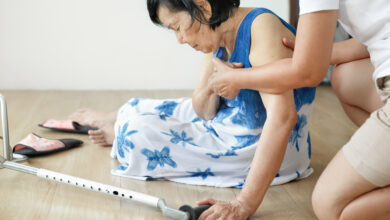In the hands of machines
Robots and other assistive technology may be inevitable in aged care moving into the future, but can they replace the human touch?
Annie May reports.
Standing at just 40cm tall and looking suspiciously like the latest toy their grandchildren have been dropping hints about for their upcoming birthdays, Matilda the robot doesn’t give the impression that she has much to offer in the way of care for the elderly.
So when placed in front of an aged care resident to talk about her diet, the resident doesn’t have high expectations. But on admitting to having a love of sweets, Matilda is quick to inform her about all the negative health impacts this indulgence can have. Becoming slightly anxious, - whether a result of being lectured by a bright orange robot or at the thought of having to cut back on her sweets - the resident is then shocked at being reassured by the robot.
How can it be that this baby-face robot can read emotions and give a sensitive response? The result of a breakthrough by Melbourne and Japanese scientists, Matilda is one of two robots, the other her brother Jack, which has been developed with ‘emotional intelligent’ software.
With its eyes actually twin cameras and its ears microphones, the robots are able to ‘read’ and respond to human emotion, such as facial cues, voice and touch. If a resident is in a low mood, Matilda can send an email to relatives to alert them that they should pay a visit.
Attracting and retaining workers to care for an aging population is already resulting in labour shortages and this has been predicted to become an increasing issue as the ageing population increases. Is technology the answer?
The reliance on robotic technology in surgical fields has been a reality for decades, but recent trends and developments has resulted in the emergence of technology in the delivery of healthcare outside the hospital, including aged care facilities.
But can, and should, robots replace the human touch? This was one of the questions raised at the Ageing – The Future Technology Challenge forum held in Sydney recently.
The short answer to that question is no, robots can’t replace humans. But they can assist them.
“Technology is all pervasive in our lives today and it is time we used it to address the social needs of our society,” Dr Rajiv Khosla, Matilda’s head inventor, told the forum.
“Technology is a tool which can help us behave more creatively. Inanimate technology only serves a purpose of convenience while these emotionally intelligent robots will enhance people’s lives.”
The director of Research Centre for Computers, Communication and Social Innovation (RECCSI) at La Trobe University, which is in partnership with Japan’s NEC Corporation and Kyoto University, said trials of Matilda in aged care facilities have found the right kind of ‘healthbots’ can bring numerous benefits to both residents and staff.
“Matilda can interact with residents in numerous ways. She can take care of dietary needs and remind residents of their medication and she can also dial up to the internet, dance and call bingo,” said Khosla.
While the task of calling bingo may not at first appear significant, Khosla said it was this type of capability that allowed nursing staff and workers to provide more personalised care.
“Matilda doesn’t replace the need of staff to be part of these activities, but instead of spending time with the mechanics of the game, they can spend it helping the residents.”
With a focus on ‘humanised technology’, Khosla said there was a strong focus on developing Matilda with human attributes. This doesn’t mean, he said, making it look like a human with arms and legs, but embodying human characteristics. The robot has a baby face, a human voice, can dance and the face has expressions, such as blushing. The facial recognition software allows it to track and memorise up to 30 different faces.
“In our trials we have not had a single adverse reaction to Matilda’s presence,” Khosla said.
In fact, they were delighted by her, said Meg Willis, lifestyle coordinator at BlueCross, the Boulevard.
Matilda has visited the Melbourne residence on five occasions as part of La Trobe University’s research project. While there she has conducted quizzes, questionnaires and has general interaction with the residents.
Initially concerned that the residents would see Matilda as a kids toy, Willis said that wasn’t the case, with them speaking back to her when asked questions. But, there was also some fun to be had.
“The residents were delighted by her. She is very personable – she blushes, nods, speaks and dances. The residents laughed and clapped along with her,” Willis said.
Taking a slightly different approach with their robot Charlie is the Auckland University Robotics Research Group.
Charlie the robot has been developed to take on routine tasks at aged care facilities including reminding residents to take their medication, monitor signs and calls for assistance if they fall.
Charlie’s role is to also entertain the residents and can play music and videos and has quizzes for brain fitness.
While Charlie will respond to hugs, there wasn’t a strong focus on “humanising him”.
Standing at just over a metre tall, Charlie is metallic and moves around on wheels. In place of a head sits a large touch screen.
“In our studies we found that residents wanted a non-humanlike appearance and a strong desire of having no face was expressed,” Dr Bruce MacDonald, director of the Auckland University Robotics Research Group, told the forum.
Despite the fact that most people have never interacted with a robot, and many elderly people had limited interaction with modern technologies, MacDonald said when trialling Charlie at a retirement village he was not only accepted, but found to be easy to use.
“Before having that interaction with Charlie, the residents expressed negative attitudes about having him in the village. But once they had that interaction, they enjoyed having him there.”
Some staff expressed concern about robots taking away jobs, but MacDonald said robotic assistants are intended to help alleviate a shortage of care staff by assisting staff with more menial tasks.
“Robots can do some of the simple things staff has to do at the moment so staff can do more complicated tasks and provide more personalised care,” he said.
“Technology, including robots, will play an increasing role in caring for the elderly but they will be used to assist staff, not replace them.”
Email: [email protected]




